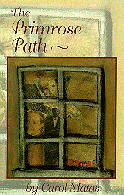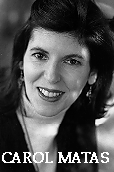
Volume 1 Number 16
September 29, 1995


|
The Primrose Path.
Carol Matas.
Winnipeg: Bain & Cox, 1995. 152pp, paper, $9.95.
ISBN 0-921368-55-0. CIP.
Grades 6 - 10 / Ages 11 - 15.
Review by Dave Jenkinson.
|
As in Sworn Enemies and The Burning Time,
Carol Matas again displays her ability to spin a good story while writing
about tough, hard hitting subject matter. Teen readers will profit
greatly by pausing to read the brief quotation from Hamlet
that precedes the opening chapter. Ophelia's concern about pastors who
preach to others ``the steep and thorny way to Heaven," while treading
``the primrose path" of pleasure themselves, foreshadows the book's
contents.
Like Ask Me No Questions by Linda Phillips, Peter Ringrose, and Michael Winter, the major focus of The Primrose Path is juvenile
sexual abuse, but here the abuser is not a parent but another trusted
adult, a Rabbi. Matas creates a convincing chain of events leading to the
abuse. Following the death of her maternal grandmother, and as a new
school year looms, Debbie Mazur, fourteen, moves with her family from the
West coast to the East. Debbie's mother, still grieving, finds emotional
solace in the charismatic Rabbi of a neighbourhood Orthodox synagogue and
decides that Debbie would benefit academically by attending the attached
Hebrew school.
As the Mazurs had previously gone to a Reform temple, Debbie
initially rebels and feels alienated by the unfamiliar Orthodox rituals
and observances. Debbie's attitudes change, though, when she is
befriended by four fellow grade-nine girls who seem to enjoy a special
relationship with Rabbi Werner, their handsome Hebrew teacher. Werner is
also the school's principal -- and the same rabbi who has been providing
such support for her mother. But as Debbie comes to discover personally,
while tickling and romping with the girls, Rabbi Werner ``accidentally"
touches their breasts. At first Debbie is embarrassed and tries to
explain away the touching, but when Rabbi Werner eventually extends his
``tickling" to her ``privates," she recognizes his behaviour to be
clearly inappropriate.

Matas effectively captures the young teen's ongoing emotional
confusion; because she initially enjoys and even wants the Rabbi's
attentions, Debbie vacillates about what to do. When she finally confides
in her father, Debbie only tells him about the Rabbi's hugging and
non-sexual tickling. Though she insists her father take no action, her
limited disclosure sets in motion a series of events that culminates in
Rabbi Werner having to appear before his board to answer not only
Debbie's charges but those of others as well.
Some adults wanting ``justice" may be disappointed by the book's
ending, for the wrongdoer is not clearly punished; however, Matas
realistically reveals what can occur when questions of morality become
tangled in adult ``politics" and reputation. Matas also adds to the book's
impact by entwining Debbie's problems with her parents' marital
difficulties. The troubled family situation increases Debbie's
vulnerability and limits her parents' ability to respond concertedly.
To help readers unfamiliar with the Jewish faith, Matas provides a
six-page glossary of terms encountered in the story.
An excerpt of The Primrose Path appeared in Volume 1, Number 15 of CM magazine.
Highly recommended.
Dave Jenkinson teaches courses in children's and Young Adult
literature in the Faculty of Education at the University of Manitoba.
This issue's advertising feature from Bain & Cox Publishers contains ordering information and more material on The Primrose Path.

Copyright © 1995 the Manitoba Library Association.
Reproduction for personal use is permitted only if this copyright notice is
maintained. Any other reproduction is prohibited without permission.
Published by
The Manitoba Library Association
ISSN 1201-9364
 Go back to CM Welcome page
Go back to CM Welcome page
 Go back to Table of
Contents for this Issue
Go back to Table of
Contents for this Issue






 Go back to CM Welcome page
Go back to CM Welcome page
 Go back to Table of
Contents for this Issue
Go back to Table of
Contents for this Issue